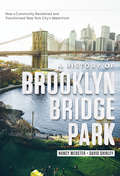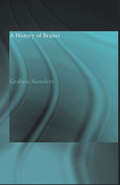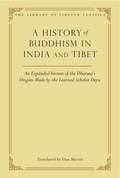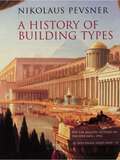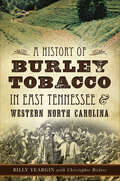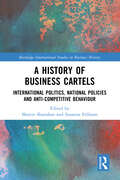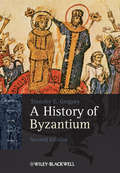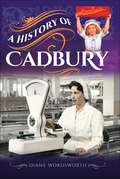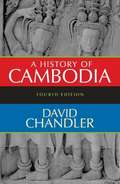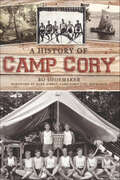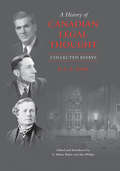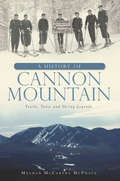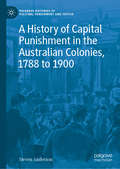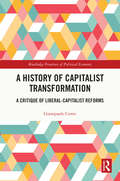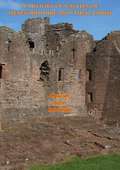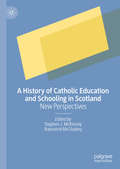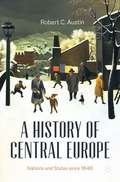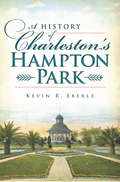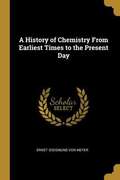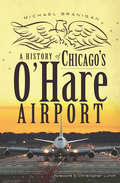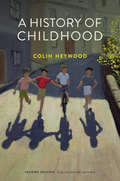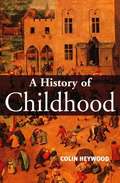- Table View
- List View
A History of Brooklyn Bridge Park: How a Community Reclaimed and Transformed New York City's Waterfront
by David Shirley Nancy WebsterBy the 1970’s, the Brooklyn piers had become a wasteland on the New York City waterfront. Today they are a stunning park that is enjoyed by countless Brooklynites and visitors from around the world. A History of Brooklyn Bridge Park recounts the grassroots, multi-voiced, and contentious effort to transform Brooklyn’s defunct piers in the mid-1980s into a beautiful, conscientiously designed park. The movement to resist commercial development on the pier sprang up spontaneously but reveals how concerned citizens came together to shape the future of their community. After winning a number of battles, park advocates collaborated to create a thoroughly unique city park that took advantage of the water and the city’s skyline, incorporating a stunning design with vibrant cultural programming.From start to finish, this history emphasizes the contributions, collaborations, and spirited disagreements that made the planning and construction of Brooklyn Bridge Park a model of natural urban development and public-private partnership. The book includes interviews with Brooklyn residents, politicians, activists, urban planners, and other key participants in the fight for the park. The story of Brooklyn Bridge Park also speaks to larger issues confronting all cities, including the development of postindustrial spaces and how to balance public and private interests without sacrificing creative vision or sustainable goals.
A History of Brooklyn Bridge Park: How a Community Reclaimed and Transformed New York City's Waterfront
by David Shirley Nancy WebsterBy the 1970s, the Brooklyn piers had become a wasteland on the New York City waterfront. Today, they have been transformed into a stunning park that is enjoyed by countless Brooklynites and visitors from across New York City and around the world. A History of Brooklyn Bridge Park recounts the grassroots, multivoiced, and contentious effort, beginning in the 1980s, to transform Brooklyn's defunct piers into a beautiful, urban oasis. The movement to resist commercial development on the piers reveals how concerned citizens came together to shape the future of their community. After winning a number of battles, park advocates, stakeholders, and government officials collaborated to create a thoroughly unique city park that takes advantage of the water and the 'Manhattan skyline, combining an innovative design with vibrant cultural programming. From start to finish, this history emphasizes the contributions, collaborations, and spirited disagreements that made the planning and construction of Brooklyn Bridge Park a model of natural urban development and public–private partnership. The book includes interviews with Brooklyn residents, politicians, activists, urban planners, landscape architects, and other key participants in the fight for the park. The story of Brooklyn Bridge Park also speaks to larger issues confronting all cities, including the development of postindustrial spaces and the ways to balance public and private interests without sacrificing creative vision or sustainable goals.
A History of Brunei
by Graham SaundersThe only full-length study of the Brunei Sultanate from the earliest times to the present. First published in 1994 and a sell-out success, RoutledgeCurzon is pleased to present this new edition, updated to the present. Saunders skilfully elucidates historiographical controversies over important events, persons and developments in Brunei's past which are still important issues in defining Brunei's identity and its political and social systems today. These controversies, over the antecedents of the Sultanate, the date of the conversion to Islam, the reigns of the early sultans, early contacts with Europeans and others, retain their relevance. Newly presented are interpretations of events since 1945 during the transition from protected state to full independence, and thence to the present Malay Islamic Monarchy.
A History of Buddhism in India and Tibet: An Expanded Version of the Dharma's Origins Made by the Learned Scholar Deyu (Library of Tibetan Classics #32)
by Dan MartinThe first complete English translation of an important thirteenth-century history that sheds light on Tibet&’s imperial past and on the transmission of the Buddhadharma into Central Asia.Translated here into English for the first time in its entirety by perhaps the foremost living expert on Tibetan histories, this engaging translation, along with its ample annotation, is a must-have for serious readers and scholars of Buddhist studies. In this history, discover the first extensive biography of the Buddha composed in the Tibetan language, along with an account of subsequent Indian Buddhist history, particularly the writing of Buddhist treatises. The story then moves to Tibet, with an emphasis on the rulers of the Tibetan empire, the translators of Buddhist texts, and the lineages that transmitted doctrine and meditative practice. It concludes with an account of the demise of the monastic order followed by a look forward to the advent of the future Buddha Maitreya. The composer of this remarkably ecumenical Buddhist history compiled some of the most important early sources on the Tibetan imperial period preserved in his time, and his work may be the best record we have of those sources today. Dan Martin has rendered the richness of this history an accessible part of the world&’s literary heritage.
A History of Building Types (The A. W. Mellon Lectures in the Fine Arts #19)
by Nikolaus PevsnerAn essential guide to vital and often overlooked features of the architectural and social inheritance of the WestThis book provides vital insights into the ways in which architecture reflects the character of society. Drawing on his immense erudition and keenly discerning eye, Nikolaus Pevsner describes twenty types of buildings ranging from the most monumental to the least, and from the ideal to the most utilitarian. He covers both European and American architecture, with examples chosen largely from the nineteenth century, the crucial period for diversification. Included are national monuments, libraries, theaters, hospitals, prisons, factories, hotels, and many other public buildings. Incisive and authoritative, A History of Building Types traces the evolution of each type in response to social and architectural change, and discusses differing attitudes toward function, materials, and style.Please note: All images in this ebook are presented in black and white and have been reduced.
A History of Burley Tobacco in East Tennessee & Western North Carolina
by Billy YearginBurley tobacco revolutionized the industry in east Tennessee and western North Carolina. What started from two farmers planting white burley in Greeneville ignited an agricultural revolution and significantly changed crops, production and quality. Burley transformed the tobacco industry with new cultivation techniques and a shift from dark and flue-cured tobacco. By the 1990s, burley tobacco production in the region had drastically declined, and it is a tradition that few local farmers still practice. Agricultural experts Billy Yeargin and Christopher Bickers take a nostalgic look at the historic rise of burley tobacco and its gradual decline.
A History of Business Cartels: International Politics, National Policies and Anti-Competitive Behaviour (Routledge International Studies in Business History)
by Martin ShanahanInternational cartels are powerful organizations that impact our everyday lives, although they are little known. This book presents 15 historical case studies of international cartels that include agricultural and mineral commodities, the machinery industry, telephone equipment, whiskey and cement. These cases reveal that international cartels manipulated prices and shared markets over many decades but that their real impact was far wider. The global convergence towards criminalizing serious cartel conduct has seen a revival in historical research on cartels and competition policy. The regulation of anti-competitive behaviour has changed over time. To understand why the US, European and other modern economies altered their policies through the 20th century, it is critical to understand when, how and why governments have interacted with, and been influenced by, business organizations such as cartels. This volume draws together researchers from different nations to examine the impact of international cartels on the experience of individual nations, those nations’ interactions with one or more international cartels, and ultimately the interactions of individual nations with the wider international community. This book will be of interest to researchers, academics and advanced students in the fields of business and economic history, political economy, and government policy, as well as those interested in cartels and their impact on the wider economy.
A History of Byzantium (Blackwell History of the Ancient World #14)
by Timothy E. GregoryThis revised and expanded edition of the widely-praised A History of Byzantium covers the time of Constantine the Great in AD 306 to the fall of Constantinople in 1453. Expands treatment of the middle and later Byzantine periods, incorporating new archaeological evidence Includes additional maps and photographs, and a newly annotated, updated bibliography Incorporates a new section on web resources for Byzantium studies Demonstrates that Byzantium was important in its own right but also served as a bridge between East and West and ancient and modern society Situates Byzantium in its broader historical context with a new comparative timeline and textboxes
A History of Cadbury
by Diane WordsworthThe history of the world-famous confectioner—maker of the Cadbury Creme Egg—from nineteenth-century shop to multinational brand. When John Cadbury came to Birmingham in 1824, he sold tea, coffee, and drinking chocolate in a small shop on Bull Street. Drinking chocolate was considered a healthy alternative to alcohol, something Cadbury, a Quaker, was keen to encourage. By 1879, the Cadburys were ready to make their historic move to Bournville, where they established their famous &“factory in a garden,&” built on the sprawling Bournbrook estate. A History of Cadbury recounts the history of this beloved British chocolatier and looks at the social impact the company has had, both on the chocolate and cocoa business and on British culture at large. This is the story of how Cadbury began, how it grew, and how it diversified in order to bring its chocolates and candies to one generation after the next.
A History of Cambodia
by David ChandlerIn this clear and concise volume, author David Chandler provides a timely overview of Cambodia, a small but increasingly visible Southeast Asian nation. Praised by the Journal of Asian Studies as an "original contribution, superior to any other existing work," this acclaimed text has now been completely revised and updated to include material examining the early history of Cambodia, whose famous Angkorean ruins now attract more than one million tourists each year, the death of Pol Pot, and the revolution and final collapse of the Khmer Rouge. The fourth edition reflects recent research by major scholars as well as Chandler's long immersion in the subject and contains an entirely new section on the challenges facing Cambodia today, including an analysis of the current state of politics and sociology and the increasing pressures of globalization. This comprehensive overview of Cambodia will illuminate, for undergraduate students as well as general readers, the history and contemporary politics of a country long misunderstood.
A History of Camp Cory (Landmarks)
by Bo ShoemakerSummertime memories of Camp Cory are awash in warm emotion. From the Reveille bugle at first light to Taps in the evening, those days were the absolute best. Skippering a K-boat on cool Keuka Lake. Silly songs and skits performed into the night. The boundless nature of genuine friendship. It is hard to explain exactly why that time is so special, how it changes lives forever. This wonderful mystery is revealed here by official Camp Cory historian Bo Shoemaker. So gather around the campfire to reminisce. Just be sure to watch out for the H Man!
A History of Canada in Ten Maps: Epic Stories of Charting a Mysterious Land
by Adam ShoaltsThe sweeping, epic story of the mysterious land that came to be called “Canada” like it’s never been told before. Every map tells a story. And every map has a purpose--it invites us to go somewhere we've never been. It’s an account of what we know, but also a trace of what we long for. Ten Maps conjures the world as it appeared to those who were called upon to map it. What would the new world look like to wandering Vikings, who thought they had drifted into a land of mythical creatures, or Samuel de Champlain, who had no idea of the vastness of the landmass just beyond the treeline? Adam Shoalts, one of Canada’s foremost explorers, tells the stories behind these centuries old maps, and how they came to shape what became “Canada.” It’s a story that will surprise readers, and reveal the Canada we never knew was hidden. It brings to life the characters and the bloody disputes that forged our history, by showing us what the world looked like before it entered the history books. Combining storytelling, cartography, geography, archaeology and of course history, this book shows us Canada in a way we've never seen it before.
A History of Canadian Legal Thought
by J. Phillips George Blain Baker R.C.B. RiskThis volume in the Osgoode Society's distinguished series on the history of Canadian law is a collection of the principal essays of Professor Emeritus R.C.B. Risk, one of the pioneers of Canadian legal history and for many years regarded as its foremost authority on the history of Canadian legal thought.Frank Scott, Bora Laskin, W.P.M. Kennedy, John Willis and Edward Blake are among the better known figures whose thinking and writing about law are featured in this collection. But this compilation of the most important essays by a pioneer in Canadian legal history brings to light many other lesser known figures as well, whose writings covered a wide range of topics, from estoppel to the British North America Act to the purpose of legal education. Written over more than two decades, and covering the immediate post-Confederation period to the 1960s, these essays reveal a distinctive Canadian tradition of thinking about the nature and functions of law, one which Risk clearly takes pride in and urges us to celebrate.
A History of Canberra
by Nicholas BrownDesigned as an 'ideal city' and emblem of the nation, Canberra has long been a source of ambivalence for many Australians. In this charming and concise book, Nicholas Brown challenges these ideas and looks beyond the clichés to illuminate the unique, layered and often colourful history of Australia's capital. Brown covers Canberra's selection as the site of the national capital, the turbulent path of Walter Burley Griffin's plan for the city, and the many phases of its construction. He surveys citizens' diverse experiences of the city, the impact of the Second World War on Canberra's growth, and explores the city's political history with insight and wit. A History of Canberra is informed by the interplay of three themes central to Canberra's identity: government, community and environment. Canberra's distinctive social and cultural history as a centre for the public service and national institutions is vividly rendered.
A History of Cannon Mountain: Trails, Tales and Ski Legends (Landmarks)
by Meghan Mccarthy McphaulCannon Mountain's history is steeped in skiing legend and lore. Rising at the western edge of New Hampshire's magnificently beautiful Franconia Notch State Park, the granite-domed mountain has been the playground of skiers since the 1930s. Here, the country's first down-mountain ski trail was cleared in 1933, the first aerial tramway was built on the mountain and the first professional ski patrol was established. More than a dozen members of the U.S. Ski Hall of Fame--whose contributions to the sport include historic racing feats, the development of ski techniques and designing countless ski areas across the country and around the world--have called Cannon their home hill. Join author and longtime Cannon skier Meghan McCarthy McPhaul on the slopes of this historic mountain.
A History of Capital Punishment in the Australian Colonies, 1788 to 1900 (Palgrave Histories of Policing, Punishment and Justice)
by Steven AndersonThis book provides a comprehensive overview of capital punishment in the Australian colonies for the very first time. The author illuminates all aspects of the penalty, from shortcomings in execution technique, to the behaviour of the dying criminal, and the antics of the scaffold crowd. Mercy rates, execution numbers, and capital crimes are explored alongside the transition from public to private executions and the push to abolish the death penalty completely. Notions of culture and communication freely pollinate within a conceptual framework of penal change that explains the many transformations the death penalty underwent. A vast array of sources are assembled into one compelling argument that shows how the ‘lesson’ of the gallows was to be safeguarded, refined, and improved at all costs. This concise and engaging work will be a lasting resource for students, scholars, and general readers who want an in-depth understanding of a long feared punishment.Dr. Steven Anderson is a Visiting Research Fellow in the History Department at The University of Adelaide, Australia. His academic research explores the role of capital punishment in the Australian colonies by situating developments in these jurisdictions within global contexts and conceptual debates.
A History of Capitalist Transformation: A Critique of Liberal-Capitalist Reforms (Routledge Frontiers of Political Economy)
by Giampaolo ConteA History of Capitalist Transformation: A Critique of Liberal-Capitalist Reforms highlights how, since the recent financial crises, the expression ‘liberal reform’ has entered common parlance as an evocative image of austerity and economic malaise, especially for the working classes and a segment of the middle class. But what exactly does ‘liberal reform’ refer to? The research analyzes the historical origins of liberal-capitalist reformism using a critical approach, starting with the origins of the Industrial Revolution.The book demonstrates that the chief purpose of such reforms was to integrate semi-peripheral states into the capitalist world-economy by imposing, both directly and indirectly, the adoption of rules, institutions, attitudes, and procedures amenable to economic and political interests of capitalist élites and hegemonic states – Britain first, the United States later – between the nineteenth and twenty-first centuries. As such, the reforms became an active tool used to promote social-economical-financial institutions, norms, and lifestyles typical of a liberal-capitalist economic order which locates some of its founding values in capital accumulation, profit-seeking, and social transformation.This book will be of significant interest to readers on capitalism, political economy, the history of the global economy, and British history.
A History of Castles of Herefordshire and Their Lords
by Charles John RobinsonForty-Two castles (or their ruins) are described in detail and their storied histories outlined.“The Western Borderland is perhaps as rich in monuments of the past as the Northern, and abounds in spots about which we may say with truth,We never tread upon them but we setOur feet upon some reverend history.But the memorials are hard to decipher, and certainly the traditions live no longer upon the lips of men. The peasant ploughs with stolid unconcern the site of some ancient camp or field of blood; the shepherd folds his flock within some ruined castle, and each is as ignorant of the past associations of the place as the modern Mexican, who shares in the astonishment of the traveller at the fragments of giant temples on which he stumbles in his native forests.The writer has no theory whereby to account for the unmerited neglect with which the relics of “Old Herefordshire” have hitherto been treated, but he indulges the hope that by means of the following pages he may be permitted to rescue one class of them from absolute oblivion and to help in preserving, if not their material fabrics, at least the historic memories of some of the Border Castles.”-Introduction
A History of Catholic Education and Schooling in Scotland: New Perspectives
by Stephen J. McKinney Raymond McCluskeyThis book analyses the development of Catholic schooling in Scotland over the course of the nineteenth and twentieth centuries. Scholarship of this period tends to be dominated by discussions of the 1872 and 1918 Education (Scotland) Acts: while these crucial acts are certainly not neglected in this volume, the editors and contributors also examine the key figures and events that shaped Catholic education and Catholic schools in Scotland. Focusing on such diverse themes as lay female teachers and non-formal learning, this volume illuminates many under-researched and neglected aspects of Catholic schooling in Scotland. This wide-ranging edited collection will illuminate fresh historical insights that do not focus exclusively on Catholic schooling, but are also relevant to the wider Scottish educational community. It will appeal to students and scholars of Catholic schooling, schooling in Scotland, as well as Christian schooling more generally.
A History of Central Europe: Nations and States Since 1848
by Robert C. AustinThis textbook offers a survey of the history of Central Europe since 1848, from the ‘Springtime of Nations’, through the world wars and communist period, to NATO and EU membership. With an emphasis on nation-building, it gives the reader a better understanding of not just political history but also of the region’s economic development and of everyday life. The book brings the reader right up to the present, considering contemporary issues such as the impact of the 2015 refugee crisis, migration out of Central Europe, the weakening of democratic institutions and the re-emergence of nationalism. Throughout, it offers fresh perspectives, gives agency to Central Europe, and pays attention to the ethnic, linguistic and religious diversity of the region. This is essential reading for students taking courses on Central/East-Central Europe. It is also suitable for courses on 19th and 20th Century Europe, or for anyone with an interest in the region.
A History of Charleston's Hampton Park
by Kevin R. EberleMost visitors to Charleston never venture far enough north to discover what residents claim as the most appealing public open space on the peninsula. Hampton Park is completely unexpected in this city famous for highly manicured gardens with clipped lawns, sculpted shrubs and precise designs hidden behind massive walls and iron gates. Hampton Park's naturalistic character was created as an antidote to the cramped conditions of the lower peninsula, and it still offers open fields of grass, walking trails, shade trees and overflowing flower beds. But the story is not that simple--it began more than three hundred years ago with Native Americans and involves early plantation life, Revolutionary War battles, horse racing, the Civil War, industrial development, civic spectacle, professional baseball, a zoo and disco.
A History of Chemistry From Earliest Times to the Present Day
by Ernst Sigismund Von MeyerThis work has been selected by scholars as being culturally important, and is part of the knowledge base of civilization as we know it. This work was reproduced from the original artifact, and remains as true to the original work as possible. Therefore, you will see the original copyright references, library stamps (as most of these works have been housed in our most important libraries around the world), and other notations in the work. <P><P>This work is in the public domain in the United States of America, and possibly other nations. Within the United States, you may freely copy and distribute this work, as no entity (individual or corporate) has a copyright on the body of the work. <P><P>As a reproduction of a historical artifact, this work may contain missing or blurred pages, poor pictures, errant marks, etc. Scholars believe, and we concur, that this work is important enough to be preserved, reproduced, and made generally available to the public. We appreciate your support of the preservation process, and thank you for being an important part of keeping this knowledge alive and relevant.
A History of Chicago's O'Hare Airport (Landmarks Ser.)
by Michael Branigan&“Delves into O&’Hare&’s past and present, based on Branigan&’s extensive research and his interviews with aviation professionals and enthusiasts&” (Chicago Tribune). In 1942, a stretch of Illinois prairie that had served as a battleground and a railroad depot became the site of a major manufacturing plant, producing Douglas C-54 Skymasters for World War II. Less than twenty years later, that plot of land boasted the biggest and busiest airport in the world. Many of the millions who have since passed through it have likely only regarded it as a place between cities. But for people like Michael Branigan, who has spent years on its tarmac, they know that O&’Hare is a city unto itself, with a fascinating history of gangsters, heroes, mayors, presidents, and pilots. Includes photos! &“This book reads like no other in the aviation industry from the historical context. Mike is a prolific writer with a knack for telling a story in a way that people can easily relate and understand.&” —TribLocal
A History of Childhood (The\cultural Histories Ser.)
by Colin HeywoodColin Heywood's classic account of childhood from the early Middle Ages to the First World War combines a long-run historical perspective with a broad geographical spread. This new, comprehensively updated edition incorporates the findings of the most recent research, and in particular revises and expands the sections on theoretical developments in the 'new social studies of childhood', on medieval conceptions of the child, on parenting and on children’s literature. Rather than merely narrating their experiences from the perspectives of adults, Heywood incorporates children’s testimonies, 'looking up' as well as 'down'. Paying careful attention to elements of continuity as well as change, he tells a story of astonishing material improvement for the lives of children in advanced societies, while showing how the business of preparing for adulthood became more and more complicated and fraught with emotional difficulties. Rich with evocative details of everyday life, and providing the most concise and readable synthesis of the literature available, Heywood's book will be indispensable to all those interested in the study of childhood.
A History of Childhood: Children and Childhood in the West from Medieval to Modern Times
by Colin HeywoodThe book explores the changing experiences and perceptions of childhood from the early Middle Ages to the beginning of the twentieth century.
